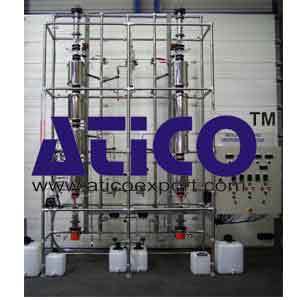Continuous Azeotropic Distillation
Specifics of the installation
Continuous Azeotropic Distillation
- Industrial instrumentation
- Cooling water flow rate alarms for the safety of the operators
- Temperature level alarms for heating element protection
- 316 L stainless steel and borosilicate glass structure
- Rigid process pipe work
- Electric heating
- Column heads with variable reflux controlled by coils
- ATEX electromagnetics
- Packed column and column with perforated trays
- Continuous azeotropic distillation
- Heat-insulated columns
Principle of Operation:
Distillation allows the separation of a mixture of compounds with different boiling points. Boiling the mixture gives off vapours from the liquid’s different components. By repeating the condensation and evaporation process, the most volatile product gradually becomes more predominant in the vapour phase. The packing in the column increases the contact surface and thus the transfer of matter. A metering pump used to introduce some of the solution at set points along the column (1/3 and 2/3 of the way up) make this a continuous operation within the unit. The vapours are condensed and then spread between the distillate (always recovered) and the reflux, via a column head fitted with a valve. The residue at the bottom of the evaporator is also constantly recovered.
The temperatures are measured at the top and bottom of the column as well as at the solution inlet points, so as to establish the temperature profile.
Teaching Objectives of Continuous Azeotropic Distillation
- Studies of the following experimental parameters:
- Study of the hydrodynamics of the packing column and of the columns with perforated trays.
- Continuous distillation.
- Continuous azeotropic distillation.
- Comparison of packing columns of columns with perforated trays.
- Impact of operating conditions on the separation of a binary solution.
- Calculations :
- Thermal balance.
- Materials balance.
- Determining the number of theoretical trays (McCABE and THIELE, PONCHON and SAVARIT).
- Determining the number of transfer units
Technical specifications
Equipment :
- Polyethylene storage container for the inlet solution; usable volume 30 litres.
- 316 L stainless steel – PTFE manual feed metering pump.
- Feed preheater with two valves for 33 % or 66 % feed of the packed column, and fitted with a minimum safety level and a maximum safety temperature.
- Continuous borosilicate glass evaporators, electric heating, with each evaporator fitted with a minimum safety level and a maximum safety temperature.
- Condensers to measure differential pressure.
- Borosilicate glass column, in three parts and thermally insulated parts with 316 L stainless steel MULTIKNIT packing.
- Borosilicate glass column, in three parts with three OLDERSHAW, thermally insulated perforated trays.
- Three 316 L stainless steel recentering trays on each column, each fitted with a sampling valve and a temperature gauge.
- Borosilicate glass column heads, with temperature gauge, and fitted with an electromagnetic timer valve to control the reflux ratio.
- 316 L stainless steel vertical condensers, borosilicate glass barrel, single effect with PTFE baffles
- Hetero-azeotropic settling tank with collection valve for the light phase for recycling towards the 316 L stainless steel column with perforated trays, collection
- Valve for the heavy phase for recycling towards the 316 L stainless steel packing column with an interface level regulator and a 316 L stainless steel cooling coil.
- Condenser – trap in the 316 L stainless steel settling tank.
- Two 316 L stainless steel condensers for the distillate and residue.
- Borosilicate glass receptacle with distillate for each column; each is fitted with a 316 L stainless steel drain valve.]
- Borosilicate glass receptacle with residue for each column; each is fitted with a 316 L stainless steel drain valve.
- Four polyethylene containers for holding distillates and residues.
- 316 L stainless steel connecting pipe work for the process and reinforced PVC for the cooling fluid.
- 304 L stainless steel tubing support structure and aluminium nut.
Instrumentation:
- Each condenser has a supply of cooling water, and is fitted with a float flowmeter, control valve and a water flow switch to shut down the heating by cutting off the cooling system.
- Measurements of pressure drops in the columns using differential, U-shaped pressure gauges.
- Control and inspection cabinet, featuring an emergency stop, start-up buttons and the following interfaces:
- Preheater temperature controller.
- Column head temperature regulators for controlling the collection valves and the reflux.
- Regulators for controlling the heating of the evaporator.
- Four numerical temperature indicators (two per column) with twenty one Pt100 Ω probes.
Dimensions and weight
- 2.9 m x 0.75 m x 3.45 m ~ 200 kg.
Essential requirements
- 230 V / 50 Hz / Single-phase: 6 kW.
- 20°C / 3 bar cold water: 2 m3/h.
- Drain.






